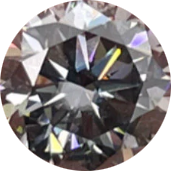Why Some Laboratory-Grown Diamonds Fail to Test as 'Diamond'

This discrepancy in testing results poses identification risks and can be confounding for consumers. Despite being chemically identical to natural diamonds, laboratory-grown diamonds may contain impurities uncommon in their naturally occurring counterparts. One such impurity is boron.
Boron, when trapped within the diamond's crystal structure, is a rare occurrence in natural diamonds, affecting their color and electrical conductivity. Laboratory-grown diamonds, particularly those produced via HPHT methods, often contain boron due to its use in the production process, leading to variations in their properties.
While boron's presence is minimal, even trace amounts can significantly impact a diamond's characteristics, including color and conductivity. This presence of boron, especially in colorless HPHT laboratory-grown diamonds, can lead to their misidentification as synthetic moissanite during basic diamond testing.
The challenge arises from the historical design of diamond testers, which primarily rely on thermal and electrical conductivity tests to distinguish diamonds from their simulants. Synthetic moissanite, with its distinct electrical properties, presents a unique challenge to these testers, complicating the identification process.
However, it's essential to note that laboratory-grown diamonds' properties may deviate from those of natural diamonds, making accurate identification crucial. While diamond testers remain valuable tools, visual inspection and additional testing methods are necessary to confirm a stone's identity, especially when dealing with laboratory-grown diamonds.
Leave a comment
Comments will be approved before showing up.
Also in Articles
 🔥 Fire Opal: The Fiery Gemstone Redefining Modern Jewelry
🔥 Fire Opal: The Fiery Gemstone Redefining Modern Jewelry
Genuine Fire Opal: A Radiant Gemstone of Fiery Elegance | Giliarto Online Jewelry
Discover the Unique Beauty of Fire Opal Jewelry
At Giliarto Online Jewelry, we celebrate the extraordinary. One of the most captivating gemstones we offer is the genuine fire opal — a luminous stone with warm, fiery hues that range from vivid oranges to intense reds and golden yellows. Whether you're drawn to its vibrant color, rare origin, or metaphysical significance, fire opal jewelry is a powerful expression of individuality and sophistication.
 Discover the Beauty of Lavender Lab-Grown Sapphires with Giliarto Jewelry
Discover the Beauty of Lavender Lab-Grown Sapphires with Giliarto Jewelry
Discover the enchanting beauty of lavender lab-grown sapphires at Giliarto Jewelry. Learn about their benefits, durability, and why they’re the perfect ethical choice for your dream ring.




























